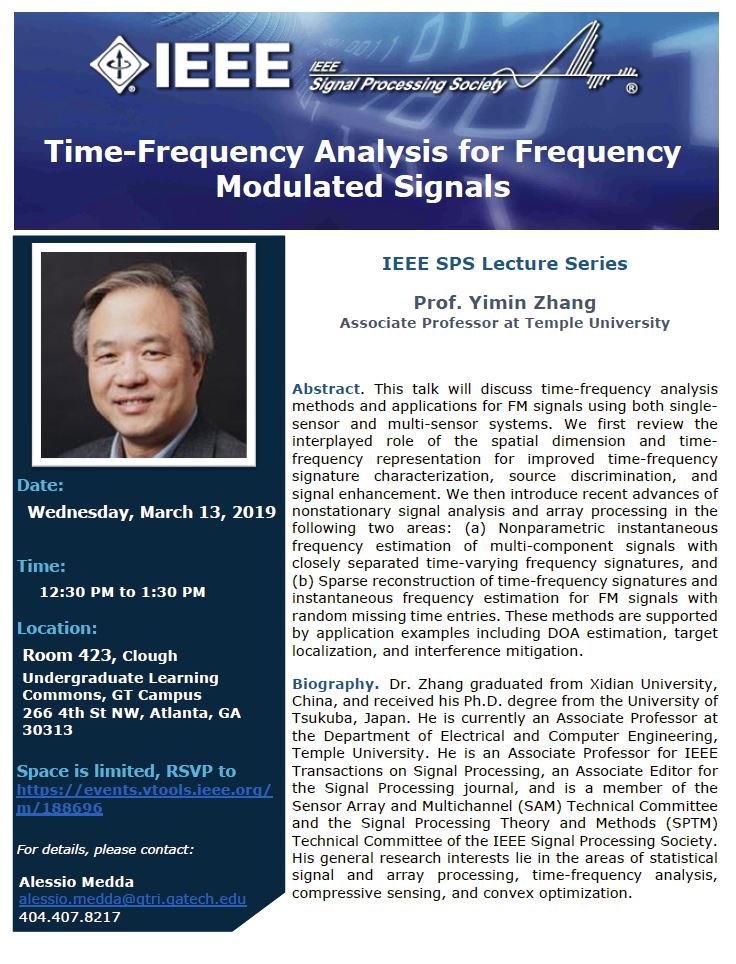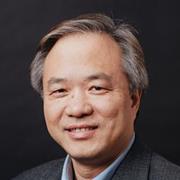Time-Frequency Analysis for Frequency Modulated Signals

The Atlanta Signal Processing Chapter is honored to host Prof. Yimin Zhang from Temple University
Professor Zhang will present a lecture on the topic of array processing and time-frequency analysis. Prof. Zhang is an Associate Professor at Temple University at the Department of Electrical and Computer Engineering. His general research interests lie in the areas of statistical signal and array processing, time-frequency analysis, compressive sensing, and convex optimization for applications in radar, wireless communications, and satellite navigation.
Parking. Parking on campus is not easy during the week. The closest visitor parking area is off of Ferst Drive after the CRC center (https://goo.gl/maps/HRaUVMLLYjT2). If you have a parking pass, I suggest finding a parking spot on Ferst Drive, or otherwise park off campus and use public transportation.
Chapter Facebook page: https://www.facebook.com/IEEESPSATL/
Date and Time
Location
Hosts
Registration
-
 Add Event to Calendar
Add Event to Calendar
- 266 4th St NW
- Atlanta, Georgia
- United States 30313
- Building: Clough Undergraduate Learning Commons
- Room Number: 423
- Click here for Map
Speakers
 Yamin Zhang
Yamin Zhang
Time-Frequency Analysis for Frequency Modulated Signals
Frequency modulated (FM) signals are frequently encountered nonstationary signals in various passive and active sensing applications, both as emitting sources and as return signals from moving and maneuvering targets. FM signals are also considered preferred waveforms for smart jamming. Time-frequency representations are the preferred powerful tool for the analysis and characterization of such signals. On the other hand, with multi-sensor arrays being ubiquitous in many application areas of signal processing, the marriage of time-frequency distribution and array processing enables transparent transformation of many second-order statistics-based array processing techniques for the processing of nonstationary signals, and supports a variety of nonstationary array signal processing techniques for direction-of-arrival (DOA) estimation, blind source separation, and waveform recovery. This talk will discuss time-frequency analysis methods and applications for FM signals using both single-sensor and multi-sensor systems. We first review the interplayed role of the spatial dimension and time-frequency representation for improved time-frequency signature characterization, source discrimination, and signal enhancement. We then introduce recent advances of nonstationary signal analysis and array processing in the following two areas: (a) Nonparametric instantaneous frequency estimation of multi-component signals with closely separated time-varying frequency signatures, and (b) Sparse reconstruction of time-frequency signatures and instantaneous frequency estimation for FM signals with random missing time entries. These methods are supported by application examples including DOA estimation, target localization, and interference mitigation
Biography:
Dr. Zhang graduated from Xidian University, China, and received his Ph.D. degree from the University of Tsukuba, Japan. He is currently an Associate Professor at the Department of Electrical and Computer Engineering, Temple University. His general research interests lie in the areas of statistical signal and array processing, time-frequency analysis, compressive sensing, and convex optimization for applications in radar, wireless communications, and satellite navigation. He is an Associate Professor for IEEE Transactions on Signal Processing, an Associate Editor for the Signal Processing journal, and is a member of the Sensor Array and Multichannel (SAM) Technical Committee and the Signal Processing Theory and Methods (SPTM) Technical Committee of the IEEE Signal Processing Society. He received the 2016 IET Radar, Sonar & Navigation Premium Award, 2017 IEEE AESS Mimno Award, and is a coauthor of a paper receiving the 2018 IEEE SPS Young Author Best Paper Award. He is a fellow of IEEE.
Address:United States

